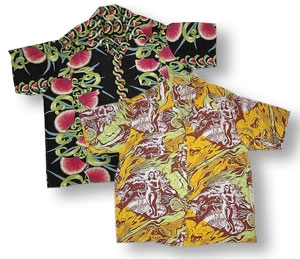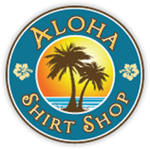More history and information about the evolution of the Hawaiian Aloha Shirt
Hawai'i' - awash in romance, marbled by different cultures, saturated with beauty, and compelling in contrasts - gave birth, over 50 years ago, to the renowned Aloha shirt. There is today probably no better-known garment in the world that captures a land's 'spirit of place.'
For half a century, the Aloha shirt has been Hawai'i's most enduring and visible greeter and ambassador - like the lei, the Aloha shirt is worn as a statement of one's love for, and connection to, a most special place.
These words from historian and waterman Tommy Holmes, from the forward of our book The Aloha Shirt, capture the true history of this marvelous cultural icon. The Aloha shirt, so evocative of the spirit of its home, is full of mystery and allure of Hawai'i' and the stories of those who have lived here.
Different tales have circulated for decades about the origins of the Aloha shirt. Did it spring forth late one night from the hand-operated sewing machine of a Japanese tailor? Was it inspired by the tail-out shirts of the Philippines, elegant kimono cloth from Japan, or vivid floral prints for Tahiti?
There are well-documented stores from the pre-World War II years of teenagers buying wonderful, finely printed Kabe crepe material, imported from Japan, in the dry-goods stores of downtown Honolulu. These young men had their mothers sew beautiful shirts from the fabric. That tradition of beautifully sewn printed shirts spread from the Asian dry-goods merchants and home-sewers to the tailors and dress-makers of Hawai'i', creating a new style of colorful clothing.
This all took place in the late 1920s and early 1930s, at the same time that Hawai'i' was emerging as a paradise for tourists with the building of the Royal Hawaiian Hotel in Honolulu and the christening of the trio of magnificent cruise ships by Matson navigation, opening this majestic string of island to the world. Boatloads of visitors were charmed by hula dancers swaying to the rhythm of a lone 'ukulele, enchanted by Waikiki Beach boys riding the waves on their great wooden surfboards. For those who came from afar, nothing painted a more vivid picture of Hawai'i' than these bold shirts with their vibrant island imagery.
The early Aloha shirts most often depicted ancient symbolic imagery of the Orient. Pine and plum tree prints represented long life, good fortune, and success. The images of a tiger symbolized strength and courage. Prints of bamboo denoted strength and flexibility. Early designs were also graced with traditional images of Mount Fuji, ornate temples, or peaceful landscapes.
It was not long before local artist began to design textiles that captivated the dreamy, romantic lifestyle of their island home. Early prints that were intended for home interiors soon made their way into clothing. Elsie Das designed beautiful botanical prints of native plants hibiscus, breadfruit, night-blooming cereus as well as a humorous pattern incorporating hula girls. Ethel Chun Lum designed shirts sold by her brother Ellery Chun at his store, King-Smith Clothiers. Ellery Chun was the first person to officially register the name "Aloha Shirt." Ether produced designs based on her first cruise to the mainland U.S., including flying fish seen from the deck of a Matson liner.

Garment manufacturers including Kamehameha and Branfleet (later know as Kahala), which initially produced Aloha shirts with Asian motifs in their humble factories in the mid-1930s, began to commission designs from local artists. Soon, visitors and locals alike were donning these wearable postcards awash with coconut trees, surfers, outrigger canoes, hula girls, and endless varieties of colorful tropical flowers, birds, and fish.
"Aloha shirts put Hawai'i' on the map," says renowned fabric designer John "King Keoni" Meigs. "The first thing people did when they arrived was to make a beeline for a department store to buy one."
Meigs was one of many flamboyant designers in the Gold Age of Aloha shirts, which ran from the 1930's to the 1950's. for inspiration, they shared the sunsets, beaches, flowers, and rainforests of Hawai'i'. They and their visionary colleagues - manufactures, artists, and retailers - formed the community that created this memorable art form.
Celebrities of the time - such as John Barrymore, Bing Crosby, and Elvis Presley - were widely photographed wearing the shirts. Duke Kahamamoku, Hawai'i's most beloved surfer and Olympic swimming champion, was the earliest and greatest promoter of the Aloha shirt. Duke even had his own line of shirts, which are widely coveted by collectors today.
Whether you fancy a collectible from the 1930's or a modern style of today, the Aloha shirt remains a symbol of the casual, carefree, and graceful Hawaiian lifestyle.
Reprinted from the Artful Living, The Legacy of Kukui'ula magazine, Spring, 2007.
Dale Hope and Gregory Tozian are the authors of The Aloha Shirt Book.


